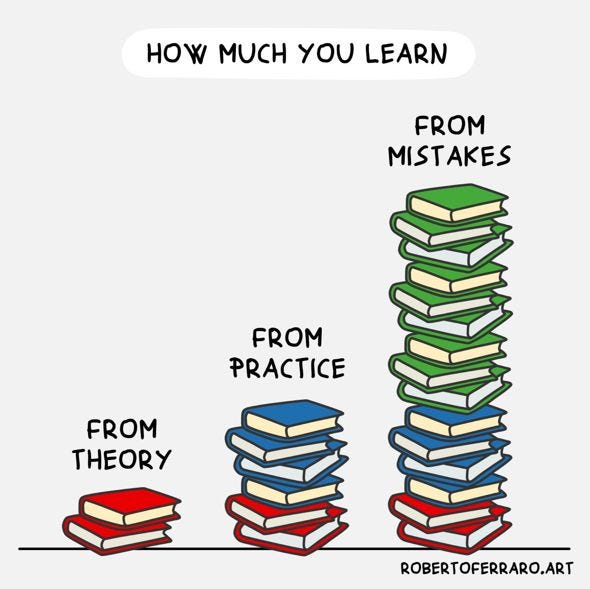Mastering Machine Learning: The 3 Stages No One Talks About
✅Learning from Theory, Practice, and Mistakes
Take this course and you will become an expert in machine learning.
Sounds familiar? Isn’t it?
Let me tell you something from my own experience. You are not going to master machine learning by just taking a course, watching a YouTube video, or taking a masterclass.
Many people think that simply taking a bunch of online courses will make them experts. This is actually far from reality!
The truth is, becoming really good at ML is more like a journey. Today, I’m sharing the 3 stages of mastering machine learning that no one talks about.
Stage 1: Learning the Theory
Every journey begins with understanding the basics.
When it comes to data science and machine learning, this means learning the theory behind the methods and tools you’ll use. It might sound boring, but having a strong foundation is really important. Think of learning theory as building a strong house, without a solid foundation, the house can’t stand up to storms.
In Machine learning, the foundations are math, statistics, and computer science. This includes topics such as probability, algebra, and the inner workings of different ML algorithms.
Another key area is learning to code. Programming languages like Python are your friends. Getting comfortable with coding will boost your confidence and problem-solving skills.
Stage 2: Learning from Practice
Now that you have the basics, it’s time to put your knowledge to work. This stage is all about getting practical experience and implementation. It’s one thing to read about how a machine learning algorithm works, and another to actually code one yourself.
Code Yourself ≠ VIBE Coding!
Starting with small projects is a great way to learn. You might begin with popular datasets. As you work with more real data, you’ll come across all sorts of challenges: missing values, messy data, and unexpected results. These experiences teach you to handle problems that you can’t always learn about in a course.
When you work on projects, don’t worry about doing everything perfectly the first time. Experimentation is key. Try out different ideas, change your code, and see what happens.
One of the biggest lessons in practice is learning to deal with messy datasets. In your projects, you’ll learn that real-world data can be very different from standard datasets. This challenge teaches you how to clean your data, choose the right methods, and think creatively about solving problems.
Stage 3: Learning from Mistakes
This is where the real growth happens. Mistakes and failures aren’t just okay! they’re a important part of learning. Every error you encounter is a chance to learn something new.
It might feel frustrating when your code doesn’t work or your model gives unexpected results, but these moments are some of the best teachers. Each mistake forces you to dig deeper, ask better questions, and refine your approach. This process not only makes you a better problem solver but also helps you understand the tools you’re using more deeply. Instead of getting discouraged, see these moments as opportunities to improve.
When you run into a problem, ask questions like, Why isn’t my model working as I expected? or What did I miss in my data? The answers often lead to valuable insights that simple practice won’t give you. This deeper understanding is what makes your skills truly robust and adaptable in different situations.
Takeaway
Mastering machine learning isn’t just about taking courses. It’s a journey that combines three important parts: understanding the theory, applying what you learn in real projects, and growing from your mistakes. I'm not against ML courses. They can be a great starting point, but practicing and learning from your mistakes are just as important.
Learn Theory: Build a strong foundation by learning the math, statistics, programming, and ML algorithms.
Get Hands-On: Use your new knowledge to work on real projects and experiment with data.
Learn from Mistakes: Embrace errors as part of the learning process. Each mistake is a chance to learn and get better.
By following these steps, you’ll move from just learning the basics to truly mastering your skills.
Don’t just learn: Apply, Experiment, and Embrace mistakes!
Next time you find yourself stuck on a coding problem or frustrated by unexpected results, take a deep breath. Realize that you’re in the middle of growing and learning something new. With each error and each small win, you’re building the skills to tackle even bigger challenges. And that’s how mastery is really achieved 🙂
Liked this article? Make sure to 💜 click the like button.
Feedback or addition? Make sure to 💬 comment.
Know someone that would find this helpful? Make sure to 🔁 share this post.
Get in touch
You can find me on LinkedIn | YouTube | GitHub | X
Book an Appointment: Topmate
If you wish to make a request on particular topic you would like to read, you can send me an email to analyticalrohit.connect@gmail.com




Clear and solid breakdown, but here’s one thing nobody says out loud:
You can go through all three stages and still not be good at ML.
Why? Because the missing fourth stage is rarely taught:
Contextual Intelligence.
– When do you not use the model?
– What matters more than accuracy?
– Can you explain your output to someone who controls the budget?
Theory, practice, mistakes, they’re necessary.
But judgment is what turns skills into value. That’s the difference between an ML student and an ML operator.
This is my favorite part: "Stage 2: Learning from Practice."
No matter what you are learning, you have to practice, make mistakes, and then make corrections. Fear of making mistakes is the failure, not the mistake itself.